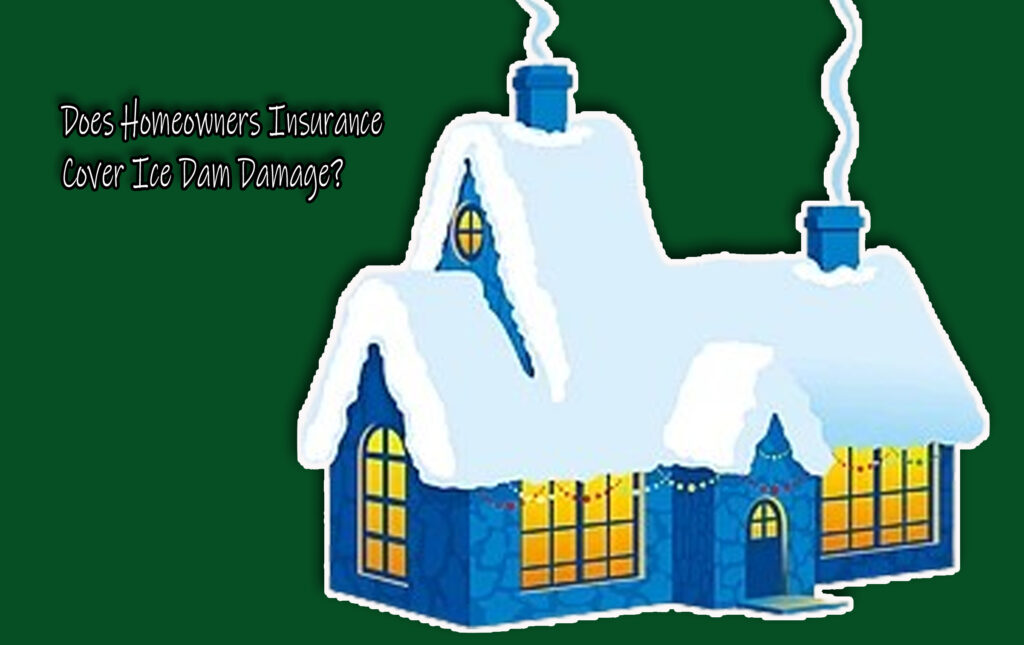Does homeowners insurance cover ice dam damage? Ice dams can cause serious trouble for homeowners during the winter. They form when snow melts on your roof and then refreezes at the edge, near the gutters.

This creates a ridge of ice that blocks more melted snow from draining off the roof. Over time, water can back up under the shingles and leak into your home. This can lead to damaged ceilings, walls, insulation, and even mold.
Now, you might be wondering, does homeowners insurance cover damage caused by ice dams? The short answer is yes, but it depends on your policy and the type of damage. So, when does homeowners insurance cover Ice dam damage? Stick with us to find out.
What Is an Ice Dam?
Before examining this insurance coverage, it’s helpful to understand what an ice dam is and why it’s a problem.
When your roof has uneven temperatures, usually because of poor insulation, snow on the warmer parts of the roof melts. That melted water flows down to the colder edges and refreezes.
Over time, this frozen barrier becomes an ice dam. As more snow melts and water collects behind the dam, it can seep under your roof and leak into your attic or walls.
This is not just a cosmetic issue. It can damage your home’s structure and lead to costly repairs.
What Kind of Damage Can Ice Dams Cause?
Ice dams can do more harm than you might expect. Some of the most common problems include:
- Water leaks in your attic or ceilings
- Stained or sagging drywall
- Damaged insulation
- Mold and mildew growth
- Warped wood or flooring
- Damaged gutters and downspouts
Some homeowners may even have to deal with roof repairs if the shingles or underlayment are affected.
Does Homeowners Insurance Cover Ice Dam Damage?
In many cases, yes. Most standard homeowners insurance policies will cover the damage that results from ice dams, but not the ice dam itself.
This means if water leaks into your home and causes interior damage, your insurance will likely help pay for the repairs.
For example, if an ice dam causes water to leak into your living room and damage your ceiling and walls, your policy may cover:
- Repairing or replacing drywall
- Repainting walls or ceilings
- Removing damaged insulation
- Drying out the area to prevent mold
However, it’s important to remember this Insurance usually covers damage that is sudden and accidental. If the damage happens over time and you didn’t take steps to prevent it, the claim might be denied.
What Is Not Covered?
While your policy may cover the effects of an ice dam, it won’t pay for everything. Here are a few things that homeowners insurance usually does not cover:
- The cost of removing the ice dam itself
- Roof damage that happened due to lack of maintenance
- Long-term water damage from slow leaks
- Mold if it was caused by neglect
- Poor insulation or ventilation issues
So, while you may get help fixing your ceiling or walls, you may have to pay out-of-pocket to remove the ice and fix the root cause, like improving insulation or roof ventilation.
How to File a Claim for Ice Dam Damage
If your home suffers from ice dam damage, act quickly. Here’s what you should do:
- Document the damage. Take clear photos of all affected areas inside and outside your home.
- Prevent further damage. If it’s safe to do so, remove wet items, cover the area with tarps, or hire a professional to stop the leak.
- Contact your insurance company. Let them know about the damage and ask what steps to follow for filing a claim.
- Hire a contractor. Some insurers may send someone to inspect, while others will ask you to find a licensed contractor for an estimate.
Keep all receipts for repairs or emergency services. These can help support your claim.
How to Prevent Ice Dams
Even if insurance covers some of the damage, it’s best to stop ice dams before they start. Prevention is always cheaper than repair. Here are a few tips:
- Add insulation to your attic: This helps keep heat from escaping through the roof.
- Seal air leaks: Gaps around pipes, lights, or vents can let warm air rise into the attic.
- Ventilate the attic: Good airflow keeps the roof cold and reduces melting.
- Use a roof rake: After heavy snow, gently remove snow buildup from your roof edges.
- Install heat cables: These can help keep gutters and roof edges clear of ice.
Some homeowners also hire professionals to do a full home energy audit. This can point out areas that need improvement.
Final Thoughts
Homeowners insurance can offer some protection against ice dam damage. It usually covers water damage that happens inside your home, as long as the cause was sudden and not due to poor maintenance. But it won’t pay to fix the ice dam itself or correct issues like poor insulation.
To avoid trouble, take steps to prevent ice dams before winter hits. Insulate, ventilate, and be proactive about snow removal.
And if you do find yourself dealing with ice dam damage, report it to your insurer right away and follow their claims process closely.



